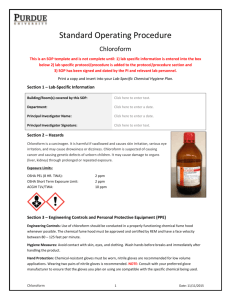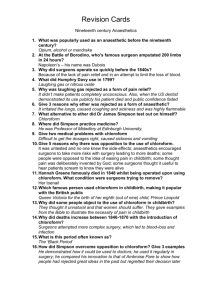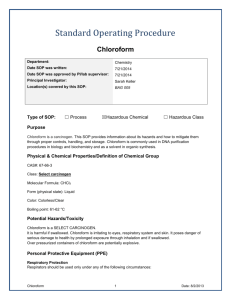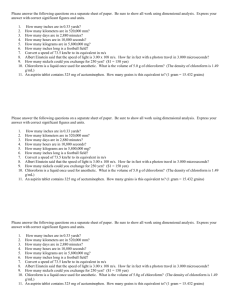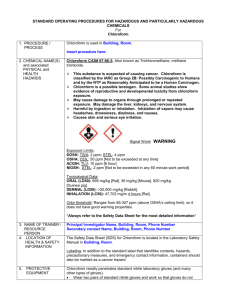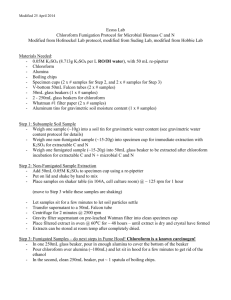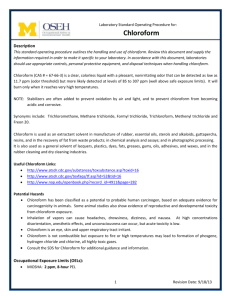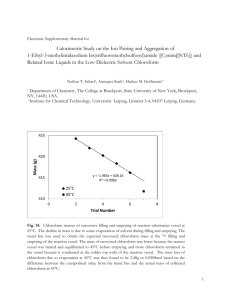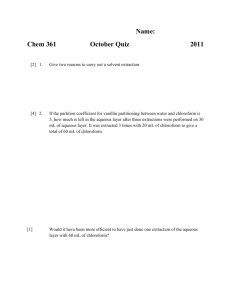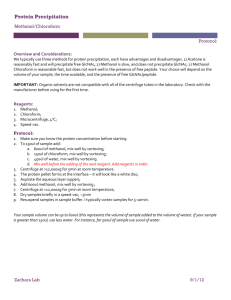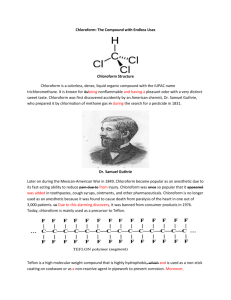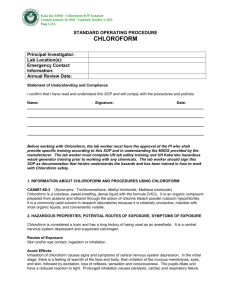Chloroform - Environmental Health & Safety
advertisement
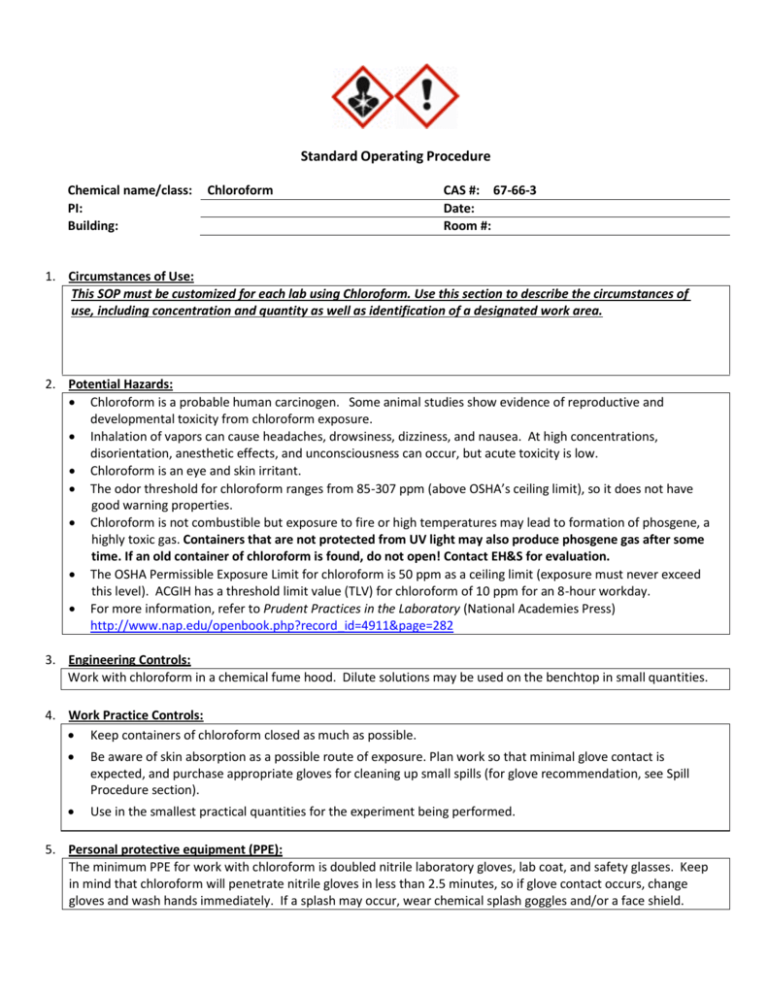
Standard Operating Procedure Chemical name/class: PI: Building: Chloroform CAS #: 67-66-3 Date: Room #: 1. Circumstances of Use: This SOP must be customized for each lab using Chloroform. Use this section to describe the circumstances of use, including concentration and quantity as well as identification of a designated work area. 2. Potential Hazards: Chloroform is a probable human carcinogen. Some animal studies show evidence of reproductive and developmental toxicity from chloroform exposure. Inhalation of vapors can cause headaches, drowsiness, dizziness, and nausea. At high concentrations, disorientation, anesthetic effects, and unconsciousness can occur, but acute toxicity is low. Chloroform is an eye and skin irritant. The odor threshold for chloroform ranges from 85-307 ppm (above OSHA’s ceiling limit), so it does not have good warning properties. Chloroform is not combustible but exposure to fire or high temperatures may lead to formation of phosgene, a highly toxic gas. Containers that are not protected from UV light may also produce phosgene gas after some time. If an old container of chloroform is found, do not open! Contact EH&S for evaluation. The OSHA Permissible Exposure Limit for chloroform is 50 ppm as a ceiling limit (exposure must never exceed this level). ACGIH has a threshold limit value (TLV) for chloroform of 10 ppm for an 8-hour workday. For more information, refer to Prudent Practices in the Laboratory (National Academies Press) http://www.nap.edu/openbook.php?record_id=4911&page=282 3. Engineering Controls: Work with chloroform in a chemical fume hood. Dilute solutions may be used on the benchtop in small quantities. 4. Work Practice Controls: Keep containers of chloroform closed as much as possible. Be aware of skin absorption as a possible route of exposure. Plan work so that minimal glove contact is expected, and purchase appropriate gloves for cleaning up small spills (for glove recommendation, see Spill Procedure section). Use in the smallest practical quantities for the experiment being performed. 5. Personal protective equipment (PPE): The minimum PPE for work with chloroform is doubled nitrile laboratory gloves, lab coat, and safety glasses. Keep in mind that chloroform will penetrate nitrile gloves in less than 2.5 minutes, so if glove contact occurs, change gloves and wash hands immediately. If a splash may occur, wear chemical splash goggles and/or a face shield. 6. Transportation and Storage: Group II, Volatile Toxin Phosgene Gas potential in old containers – date your chloroform bottles when received and when opened. Do not store chloroform with incompatibles. Chloroform is not compatible with the following: acetone, alkalis, chemically-active metals (such as aluminum magnesium, sodium, or potassium), dinitrogen tetroxide, fluorine, triisopropylphosphine, and solid potassium tert-butoxide. Store in secondary containment. Avoid storing on the floor. Transport chloroform in secondary containment, preferably a polyethylene or other non-reactive acid/solvent bottle carrier. 7. Waste Disposal: Handle and store chloroform waste following the guidelines above while accumulating wastes and awaiting chemical waste pickup. Chemical waste must be disposed of following UNC Charlotte’s Laboratory Chemical Waste Management practices https://safety.uncc.edu/laboratory-and-research-safety/hazardous-universal-waste. 8. Exposures/Unintended contact: Flush exposed eyes or skin with water for at least 15 minutes, then seek emergency medical attention. For volatile toxic liquids, remove all persons from the contaminated area. (It may be necessary to go outside.) Call 911 from a campus phone or 704-687-2200 from any phone to request assistance if needed. Contact the Student Health Center at 704-687-7400 for exposure-related advice. If the Student Health Center is closed, obtain treatment at University Hospital. The work-related injury or illness report found at: http://safety.uncc.edu/workers-compensation/workers-compensation-section 9. Spill Procedure: Spills of chloroform inside a chemical fume hood, or small spills outside a hood, may be cleaned by laboratory personnel. Wear appropriate gloves, splash goggles, lab coat (and impermeable apron, if available) and use absorbent pads to absorb spilled material. Appropriate gloves must be worn since chloroform readily penetrates standard laboratory nitrile, neoprene, and latex gloves and glove contact will occur during cleanup. Vition gloves are recommended for spill cleanup. Contact EHS at 704-687-1111 for pick-up of spill clean-up materials (including contaminated PPE). On the UNC Charlotte campus, “large” spills of volatile hazardous materials, including chloroform, must be referred to the Campus Police by calling 911 from a campus phone or 704-687-2200 from any phone. 10. Training of personnel: All personnel are required to complete the UNC Charlotte EHS Laboratory Environment Training Checklist. This checklist includes an introduction to general chemical safety as well as review of the laboratory specific safety plan. Furthermore, all personnel shall read and fully adhere to this SOP when handling the chemical. “I have read and understand this SOP. I agree to fully adhere to its requirements.” Last First UNC Charlotte ID Signature
